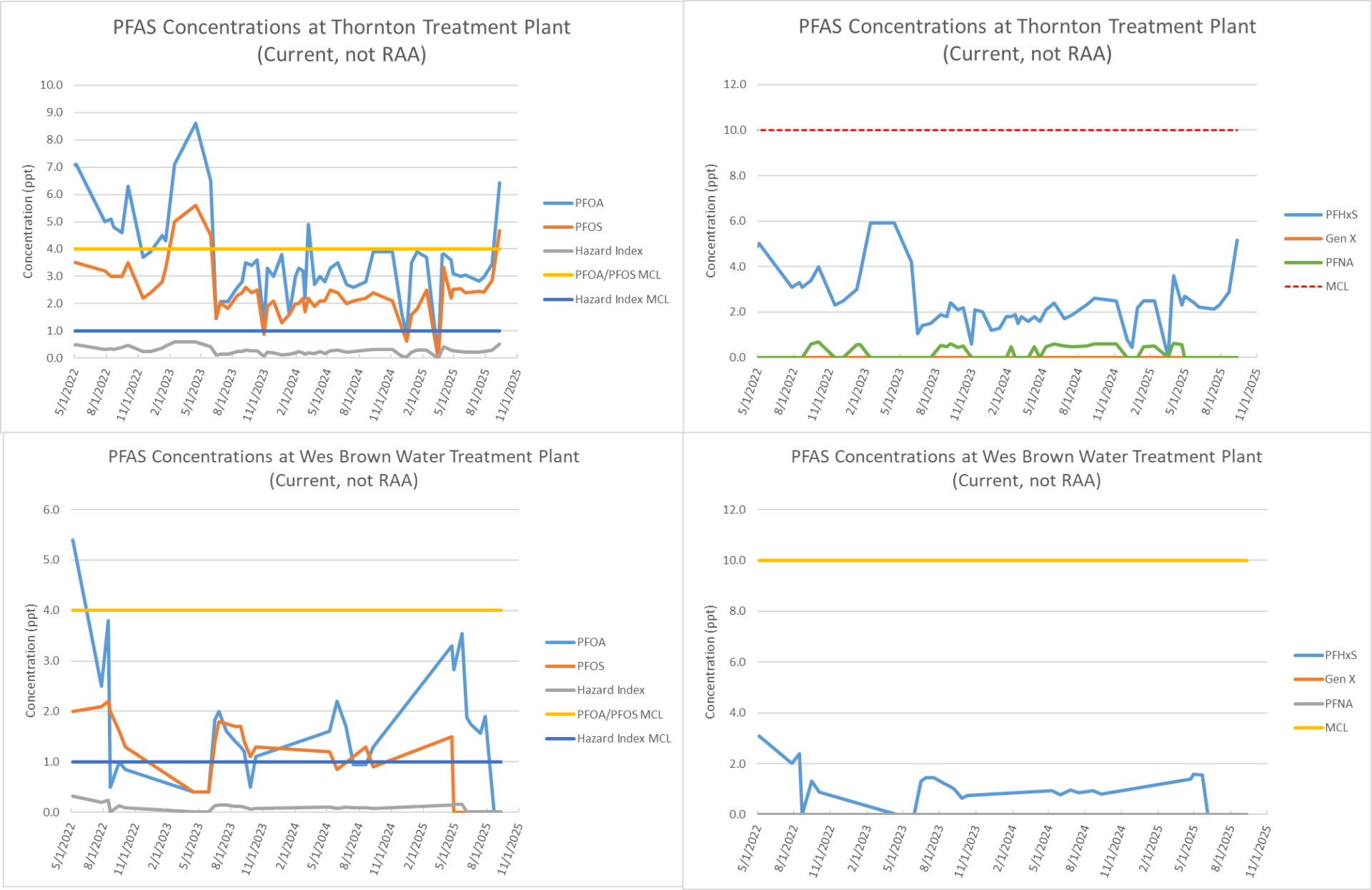PFAS Chemicals and Thornton’s Drinking Water
In May 2025, EPA signaled their intent to extend the PFAS National Primary Drinking Water Regulation (NPDWR) compliance deadline to 2031 and to remove the Hazard Index from the rule. EPA intends to go through the rulemaking hearing for this effort by the end of this year. Thornton is maintaining it’s timeline for designing and constructing PFAS removal technologies, with the goal to meet the original rule’s regulatory deadline.
Please see the table below for the MCLs of the regulated PFAS compounds; compliance will be based on the average concentration of the previous 12 months of data (Running Annual Average or RAA). Thornton remains on pace to meet these regulations prior to the compliance deadline. The graphs below show how Thornton has compared to the final rule since the city began monitoring for PFAS. The city has been working with engineering consultants to design and build new treatment processes to remove PFAS from the drinking water. City staff are currently evaluating PFAS removal effectiveness and cost considerations of preliminary engineering designs for treatment options. Other steps Thornton has taken to protect our customers include blending water sources when available to reduce PFAS concentrations, shutting down groundwater wells that have high concentrations of PFAS, increasing Powdered Activated Carbon doses to reduce PFAS concentrations, and installing a new laboratory instrument to increase our ability to monitor PFAS compounds in our source and drinking waters.
Background:
Per- and poly-fluoroalkyl substances (PFAS) are a group of manufactured chemicals that have been used in industry and consumer products since the 1940s. PFAS have characteristics that make them useful in various products, including nonstick cookware, waterproof clothing, stain-resistant carpets and fabrics, firefighting foam, and certain manufacturing processes. There are thousands of different PFAS. The domestic production or use of some PFAS (like PFOA and PFOS) has been largely phased out, but others continue to be used.
PFAS tend to break down extremely slowly in the environment and can build up in people, animals, and the environment over time. PFAS have been found in water, air, and soil across the nation and around the globe. Because of this, PFAS can end up in the water sources communities rely on for drinking water. Scientific studies show links between certain levels of PFAS exposure and harmful health effects in humans and animals.
EPA NPDWR:
The final rule that the US EPA released in April 2024 will establish Maximum Contaminant Levels (MCLs) for six PFAS compounds: PFOS, PFOA, PFHxS, GenX, PFNA, and PFBS. The table below summarizes the regulation, including Maximum Contaminant Level Goals (MCLG) as well. Compliance with the rule will be based on the average concentration of the previous 12 months of data (Running Annual Average or RAA). Last updated: 10/29/25.
| Compound | Units | MCLG | MCL | Thornton Water Treatment Plant RAA | Wes Brown Water Treatment Plant RAA |
|---|---|---|---|---|---|
| PFOS | ppt | 0 | 4 | 2.2 | 0.2 |
| PFOA | ppt | 0 | 4 | 3.2 | 1.8 |
| PFHxS | ppt | 10 | 10 | 2.3 | 0.5 |
| GenX | ppt | 10 | 10 | Not Detected | Not Detected |
| PFNA | ppt | 10 | 10 | 0.2 | Not Detected |
Hazard Index (Evaluates PFHxS, PFNA, PFBS, and GenX as a mixture) | unitless | 1 | 1 | 0.3 | 0.1 |
Thornton’s PFAS Status (updated 10/29/25):
Thornton has been actively monitoring for PFAS and adjusting treatment processes to lower PFAS in our customer’s drinking water. We fully expect to be able to comply with the proposed rule when it takes effect. See the graphs below which show data trends over time for the various PFAS compounds and their concentrations leaving the two treatment plants.

Learn more about new Health Advisory Limits (HAL) of PFAS chemicals and Thornton's drinking water:
PFAS Resources
- U.S. Environmental Protection Agency PFAS page
- Colorado Department of Public Health and Environment statement on PFAS and drinking water safety [PDF/66KB]
- Thornton’s public notice letter for PFAS exceeding the Health Advisory Level [PDF/252KB]
- Carta de aviso público de Thornton sobre PFAS que exceden el nivel de aviso de salud [PDF/236KB]
